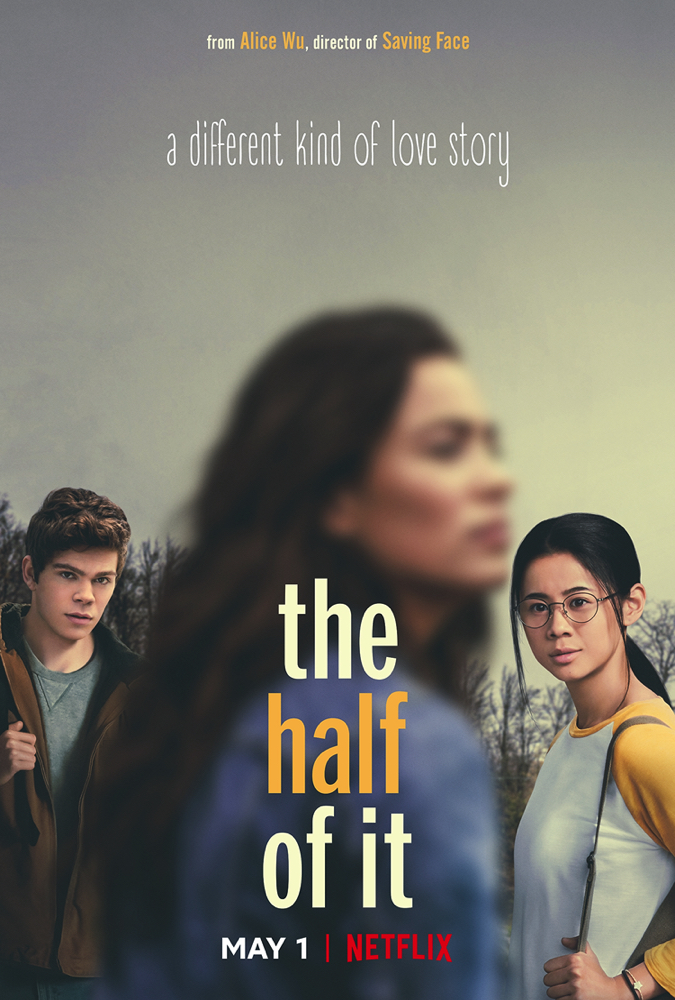
The Half Of It: Discussion Guide

The film The Half of It, directed by Alice Wu and now streaming on Netflix. “Shy, straight-A student Ellie is hired by sweet but inarticulate jock Paul, who needs help winning over a popular girl. But their new and unlikely friendship gets complicated when Ellie discovers she has feelings for the same girl.” GLSEN + Netflix are partnering in creating this discussion guide. The Half of It is available on Netflix starting Friday, May 1st.
About The Half of It
Written and Directed by: Alice Wu
Produced by: Anthony Bregman, M. Blair Breard, Alice Wu
Cast: Leah Lewis, Daniel Diemer, Alexxis Lemire, Enrique Murciano, Wolfgang Novogratz, Catherine Curtin with Becky Ann Baker and Collin Chou
Website: Netflix.com/TheHalfOfIt
Trailer: https://youtu.be/B-yhF7IScUE
Social Media: #TheHalfOfIt
Rated PG-13 for language and underage drinking.
Parents strongly cautioned.
May not be suitable for ages 13 and under.
Content warnings: Racism, Microaggressions, Homophobia, non-consensual kissing, anti-LGBTQ religious implications, grief, PTSD, underage drinking.
How to Utilize The Half of It to Create Discussion
You can host a virtual movie night and use this guide and the discussion questions (choose 3-4) below to start conversations in your GSA, diversity club, leadership class, or other virtual youth group. Topics such as identity, heteronormativity, coming out, consent, and social class are interwoven throughout this film and can spark conversations and how it relates to our own experiences. When starting your discussion, use this GSA Guidelines for Respectful Conversations.
Terms to Know
- Cisnormativity: The assumption that cisgender identity and stereotypical appearance is the norm, which plays out in interpersonal interactions and institutional privileges that further the marginalization of transgender including nonbinary and gender nonconforming people.
- Consent: Consent occurs when one person voluntarily agrees and communicates clearly to the proposal or desires of another that include but are not limited to: any form of touch, conversations, images/visuals, shared information, etc.
- Heteronormativity: Heteronormativity is the assumption that heterosexual identity is the norm, which plays out in interpersonal interactions and institutional privileges that further the marginalization of lesbian, gay, bisexual, pansexual, asexual, and queer people etc.
- Model Minority Myth: The Model Minority Myth is based on racial stereotypes that “appear” to benefit an identity group, but actually have a much deeper complex, negative, and long term impact.
Thematic Discussion Questions
General Questions
- “Bold” is used throughout the film, “...the difference between a good painting and a great painting, is typically five strokes. And they’re usually the five boldest strokes in the painting. The question of course, is which five strokes?”
- What are Ellie’s, Paul’s, and Aster’s “boldest strokes” in the film? Have you made bold strokes?
Identity
- The film touches on different ways of being “othered”, what are some of the identities these characters hold? (consider race, sexuality, socioeconomic status, religion, and ability)
- In what ways do you think privilege is connected to each of these identities?
- Ellie’s character might allude to the Model Minority Myth because of Asian stereotypes such as being really smart, closed off and unemotional, hard working, and plays the piano. What about Ellie did we learn as more of her story is revealed?
- How might each of the characters experienced feeling like an outsider?
- How does bullying show up in the film? How does bullying show up across different identities and why?
- How does Paul show up in allyship with Ellie?
- What can you as an individual do to support the person being bullied, and intervene when harassment is happening?
Heteronormativity and Cisnormativity
- There is a moment when Ellie and Paul are shopping and she chooses an outfit because she thinks it is what she is “supposed” to wear even though she does not like it. Paul helps her out and selects clothes similar to her personal style which surprised Ellie. What expectations of your identity have you felt pressured to look, dress, or act like (consider fashion/dress stereotypes)? How did that impact how you felt about your identity?
- There are a few moments in the film where Ellie’s true feelings were almost revealed to Paul, like when he offered to pay Ellie and she refused, when they were first in the locker room and talked about how they know what love is. Why were Ellie’s true feelings oblivious to Paul?
- Where else does heteronormativity show up in the film?
Consent
- Paul and Ellie have a conversation about how one “knows” if it is ok to go in for a kiss. Paul says there is a long look and then you go for it. As we move towards respecting each person's bodies and boundaries, what are ways we can engage with one another with consent?
- What are some other consent based engagements besides touching?
Relationships
- How does Paul’s understanding of “love” change throughout the movie?
- In the film, we see a glimpse of each of the main character’s relationships with their families. How does this impact each character?
- At the end of the film, Aster says “...if things were different. If I were different.” Ellie challenges her and Aster finally says “watch, in a couple of years, I am going to be so sure.” What is Aster talking about?
- How have you explored your own identities?
- How has support shown up throughout the film?
- What does support look like for you and how do you communicate this to the folks who care about you?
“Love is messy, and horrible, and selfish...and bold.” -Ellie Chu
